Uniforms & Equipment
We represent soldiers from a line company of the 19th Regiment of Foot in the Crimea from 1854-56. At the battle of the Alma, 20th September 1854, the regiment wore the full dress kit consisting of Albert Shako, red coatee, leather neck stocks, and regulation Oxford Blue woollen trousers. The knapsacks (or back packs) had been left on the transport ships, as it was decreed that the soldiers were not strong enough after suffering from cholera outbreak prior to the invasion of the Crimea. Instead, the soldiers wore the knapsack straps with the greatcoat and blanket bundled up behind. In addition, the soldiers would wear an ammunition box suspended from a leather belt over the left shoulder, a waist belt with percussion cap pouch and bayonet attached, and also a haversack containing their food, and a wooden water bottle. They were armed with the new 1851 Miniť Rifled Musket and bayonet.
During the Battle of the Alma, the troops threw away their hated Shakos and neck stocks, replacing the former with a woollen forage cap (Kilmarnock or pork-pie hats) from their haversack. As the campaign wore on through the harsh winters of the Crimea and into the siege of Sevastopol, regulation kit was continually being replaced or covered up with local indigenous clothing, such as sheep skin jackets and leggings. At the Battle of Inkerman, the regiment fought in their greatcoats and forage caps.
The Headwear
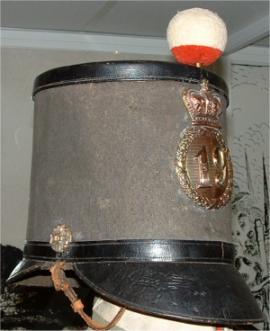 |
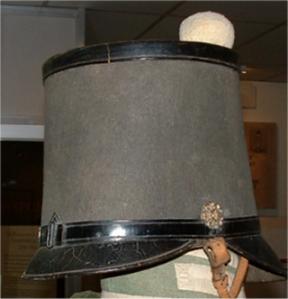 |
| Albert Shako, 19th Regt Foot, courtesy Green Howards Museum. | |
The Albert Shako was made of pressed and steamed black felt, with a lacquered leather top, front and rear peaks, and band with rear buckle for adjusting the fit. It measured 6.75 inches tall and was 0.75 inch less in diameter at the top than the bottom. On the front was a 4.5 inch tall brass plate with the regimental numerals of "19" (plus a grenade or bugle for the flank companies of Grenadiers or Light troops respectively.) On top at the front was a 2.5 inch diameter worsted ball tuft, coloured white for Grenadier, green for Light, and white over red for Centre companies. Brass rose ornaments at the side secured the leather chinstrap.
 Forage Caps were of the Kilmarnock, "pork-pie" type made of dark blue wool. On top was a woollen ball tuft coloured white for Grenadier, green for Light, and blue for Centre companies. The regimental numerals of "19" were worn at the front (plus a grenade or bugle for the flank companies of Grenadiers or Light troops respectively.) The troops had been allowed to carry these in their reduced kit, and at the Alma they were pulled out of their haversacks to replace the detested shakos.
Forage Caps were of the Kilmarnock, "pork-pie" type made of dark blue wool. On top was a woollen ball tuft coloured white for Grenadier, green for Light, and blue for Centre companies. The regimental numerals of "19" were worn at the front (plus a grenade or bugle for the flank companies of Grenadiers or Light troops respectively.) The troops had been allowed to carry these in their reduced kit, and at the Alma they were pulled out of their haversacks to replace the detested shakos.
After the Alma, the forage cap was more in evidence than the shako, the latter being relegated to being used as receptacles for rubbish, camel dung, and earth for earthworks.
Coatees
Despite the recent experiences of combat in the colonies and a more relaxed dress code, a war in Europe required the British soldier go to campaign in full dress uniform. This meant all ranks were to wear the red coatees with lace trims, little changed since Waterloo. The coatee was waist length at the front, but had tails behind each between 14.75 in. and 16 in. long for men between 5 ft. 7 in. and 6 ft. tall. The tails were between 6.5 in. and 7.5 in. wide at the top, tapering to 5 in. at the bottom, and edged with white turnbacks. The open collar was 3 in. deep at the back, tapering to 2.75 in. at the front. As the collars were open, the men were expected to wear a leather stock around their necks. On campaign, the stocks were dispensed with and the collars turned down for comfort. The rank and file coatees were of a coarse red cloth and were single breasted, fastened down the front with ten pewter regimental buttons, spaced in pairs for the 19th Foot. On either side of each button were stitched strips of white worsted lace, 5.5 in. long at the top, 2.25 in. at the bottom. There were three different designs for these lace strips, that of the 19th Foot being square-ended. The collars, cuffs and shoulder straps were all in the regimental facing colour of green and laced. At the cuffs were two pairs of buttons sewn on top of the lace. At the end of each shoulder strap Centre Companies wore a white worsted crescent; whilst the Flank Companies wore a red wing, laced and edged with white worsted. There were two buttons at the centre rear waist, 2.5 in. apart, above the tails.
 |
 |
| Centre Company Coatee 1854, 19th Regt Foot, courtesy Green Howards Museum. | |
The coatees of Colour Sergeants and Sergeants were the same as other ranks except they were of scarlet and superior cloth, unlaced in front, and double-breasted. They wore a crimson worsted sash around the waist. The rank badges for all NCO's were worn on both sleeves by Flank Companies, and on the right sleeve only by Centre Companies. Colour Sergeants wore their special rank badge on the right sleeve, and a three-bar chevron on the left.
Trousers
All ranks wore the winter pattern cloth trousers of a very dark shade of grey called "Oxford Mixture", with a quarter inch wide red welt showing along the outer seam. They opened at the front with a fly and five buttons. The side seams measured 45-49 in. depending on height, and the width around the thigh, knee and base averaged 24, 19 and 19 in. respectively. They reached well up above the waist at the back, and came well down over the boots, hence the common practice of turning up the bottoms.
The only other regulation items of clothing specified were shirts, a leather stock, braces, socks and boots. The shirts were probably of white cotton or flannel with a small turn-over collar and neck button, with long sleeves. Braces were probably of canvas material, with a one-button fastening at each front attachment point, and crossing at the back to two more buttons. Socks were of undyed wool. The ubiquitous stocks were still in use by the 19th Foot up until the Alma, after which they were dispensed with, and black neckerchiefs acquired instead.
Accoutrements
 |
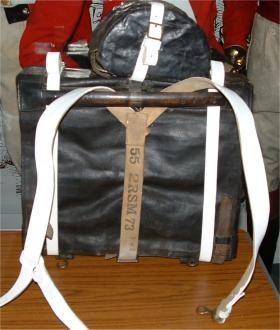 |
| Knapsack with mess kit attached, 19th Regt Foot, courtesy Green Howards Museum. | |
The heavy wooden framed back packs or knapsacks had been ordered to be left behind on the ships when the army invaded the Crimea. Instead, the back pack straps were use to hold a bundle consisting of the folded great coat and blanket. Inside the blanket bundle the men had their spare pair of boots, socks, and shirt. A semi-circular mess tin kit covered in oilcloth was attached to this bundle, as was a supply of firewood. Some men also carried a bill hook or a camp kettle attached to their back straps.
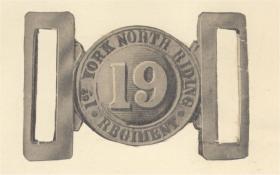 The men also carried a haversack containing their three day rations of greasy pork and biscuits, a blue painted wooden water bottle, an ammunition pouch (or box) and belt, and a waist belt with a percussion cap pouch and bayonet attached. The ammunition box contained 60 rounds and 75 percussion caps and was worn suspended over the left shoulder from a 2.5 in. wide buff leather belt. The adjustable waist belt with a fixed bayonet frog for the rank and file (sliding frog for sergeants) was fastened by a brass clasp with the regimental number in the middle and the letters "1st YORK NORTH RIDING REGIMENT" around the circle. The small brown leather cap pouch was worn to the right of the belt buckle and contained percussion caps for immediate use only.
The men also carried a haversack containing their three day rations of greasy pork and biscuits, a blue painted wooden water bottle, an ammunition pouch (or box) and belt, and a waist belt with a percussion cap pouch and bayonet attached. The ammunition box contained 60 rounds and 75 percussion caps and was worn suspended over the left shoulder from a 2.5 in. wide buff leather belt. The adjustable waist belt with a fixed bayonet frog for the rank and file (sliding frog for sergeants) was fastened by a brass clasp with the regimental number in the middle and the letters "1st YORK NORTH RIDING REGIMENT" around the circle. The small brown leather cap pouch was worn to the right of the belt buckle and contained percussion caps for immediate use only.
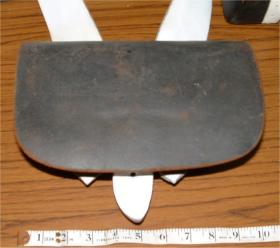 |
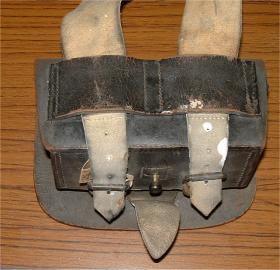 |
| Ammunition Pouch, 19th Regt Foot, courtesy Green Howards Museum. | |
Weapons
The 19th Foot were equipped with the newly issued 1851 pattern Minié rifled musket. This weighed 10 lbs., was 4 ft. 7 in. long overall, with a 39 in. barrel, a calibre of .702 in., and a leaf back-sight graduated from 200 to 1000 yards. It was a muzzle loading percussion weapon with four rifled grooves in the barrel. Accuracy at 800 yards was reckoned to be about 77% for an 8 ft. square target. The Minié's bayonet weighed 15.5 oz. and had a 17 in. triangular blade being carried in a black leather scabbard with brass mountings.

Piling Arms (Photo by Roger Fenton)
Orders of Dress
Review Order
Ammunition Pouch and waist belt only
Guard Mounting Order
As Review Order. When the greatcoat was carried, it was folded into a 17 by 11 inches rectangle and positioned so that the top was in line with the bottom of the collar.
Light Marching Order
Belts and knapsack, with the mess-tin secured to the top and the upper edge of the knapsack in line with the bottom of the collar. The greatcoat was carried within the knapsack, which contained the following reduced kit:-
1 pair of boots
1 pair of socks
1 shirt
1 towel
1 hold-all containing washing and eating utensils
3 brushes and tin of blacking
Soap, pipe clay and sponge
Heavy Marching Order
The greatcoat was rolled and secured to the top of the knapsack, which contained a full kit. The mess-tin was placed flat on the knapsack below the greatcoat, the top of the tin being in line with the top of the pack and fastened with its own strap to the two straps on the outside of the knapsack. If a blanket was issued, it was folded on the outside of the knapsack, under the straps. When haversacks and water canteens were carried, they were usually slung over the right and left shoulders respectively.


19th Foot Bandsman and Drummer 1852